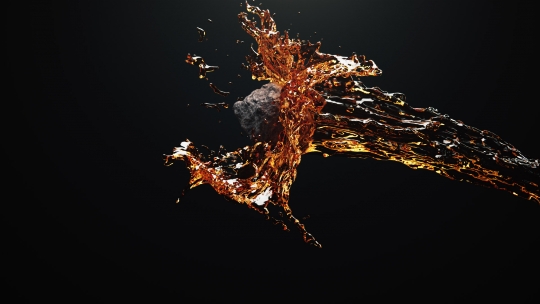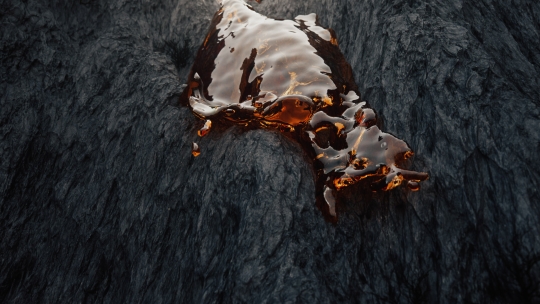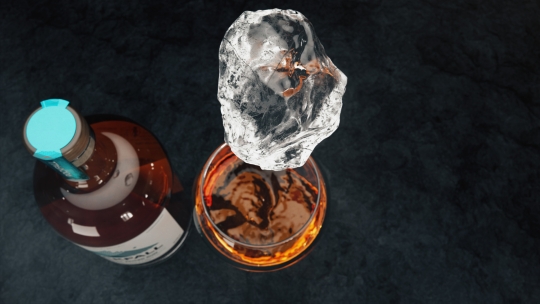With eye-catching fluid simulations, mountains, rockfalls and particles. We just had to chat to the creators about how this project came to fruition.
Hi Tristan, thanks for taking the time to chat with us about your recent work with Rockfall Spiced Rum. Before discussing the project, could you tell us about yourself and Frantic?
Frantic is a collective of like-minded artists pushing to produce the best work possible in the motion design and 3D space. I started the studio in its current form in 2017 but have been running my own motion design and production studios since graduating in 2001. I didn’t get fully into 3D until around 2015, but I have never looked back since then. It’s a discipline that allows for endless creative expression, and the tools get better and better too, meaning less time being held up by software and rendering and more time for creating.
The aim for Frantic as an animation studio is now as it has always been; to deliver work that is both beautiful to watch and effective in communicating its message.
The write-up on your website states the animation was something of a dream brief for you. Can you expand on this further?
We had a lot of creative freedom, with the brief being simply to tell the story of how Rockfall Spiced Rum is ‘best served on the rocks’ through the medium of a 30 second CGI animated ad. Of course, there are many ways this could be interpreted. Still, we decided to bring to life the concept of a real rockfall happening on the side of a mountain, with a matching ‘river/waterfall’ flowing down the other side (made of rum, naturally).
The solid rock and the liquid rum collide, turning the rock to ice, before dropping into the glass and showing the real meaning of ‘on the rocks’ with the product front and center.
The integration of the Rockfall logo into the animation is fantastic. Bringing the branding to life in a unique way draws in the viewer. Can you tell us how you created the falling rocks and debris within this scene?
The rocks and debris were modeled as simple awkward shapes in Cinema 4D before a noise displacement was added to give more texture and realism to the forms. For the materials, we used a combination of GSG rock materials and some procedural materials. Additional dynamic debris was added to explode at the points where the main rock hits the mountain. Finally, extra smoke and dust were added in post to give a greater sense of depth and realism.

The fluid simulations in this spot rightly take center stage. Can you discuss how these fluid effects were created and why you chose to use X-Particles for the fluid simulations?
We’re no stranger to creating fluid simulations, but this was the first time we’d really got stuck into X-Particles for this purpose. What drew us to use it is the ease with which a scene can be set up and the speed you can test out different simulations, tweaking as you go. There are endless possibilities for things to fiddle with, but in the end, the beauty is that you don’t need to push too far away from the default in many instances for the most realistic look. Adjusting the mesh was also straightforward, and we were quickly able to replicate the surface tension and viscosity of Spiced Rum required in this spot.

Towards the end of the spot, the rock transforms into a chunk of ice that drops into the rum-filled glass while another rock crash lands beside it. The subtlety of the camera shake and dust adds a real sense of power to the shot. So how do you go about injecting this sort of realism into your work?
I think realism is very much an iterative process. You can always work on more details to add, but on the flip side, there will always be time and budget constraints to every project. The key is to focus on the things that will make a real difference to the look and feel of the work.
Another aspect when trying to create realism is to emulate real-world cinematography. Avoid ridiculous camera moves that would never be possible on a real-life film set, and you can’t go too far wrong (admittedly, drones have somewhat changed what’s possible in real life, but you get the idea). An exception to that rule is if you are going for a more stylized look that doesn’t rely on recreating reality, like in a Spiderman movie where crazy moves are necessary to follow, you know, Spiderman.

What was the most challenging aspect of this project to complete?
The most challenging aspect was the deadline. We had less than four weeks to complete the project from concept to delivery in multiple formats, so we had to be on our A-game, even more than usual.
We avoided any major pitfalls by sticking to a ruthlessly organized schedule and flagging any issues early. We had also recently invested in new hardware, which enabled both rapid testing of simulations and rapid rendering through a multiple GPU onsite render farm.
Being able to set up, simulate and render a fluid scene quickly was essential, and I don’t think we could have done that without both X-Particles and Redshift.
Tristan, thanks again for chatting with us today. Before you head off, would you mind dispensing some advice for an aspiring Digital Artist that may read this?
If you’re right at the start of your career, my advice would be to produce as much work as you can. Stay up late. Make it your obsession. Try things. Fail. Learn. Hone. That’s what I did when I didn’t have a motion portfolio straight out of university (it was a traditional, static graphic design course). Within six months, I had made enough for a short reel, which enabled me to pick up my first paying clients.
My advice to someone with a few years under their belt would always be to aspire to produce your best work each time you start a new project. It’s very easy to get stuck in a rut and start churning out the same work week in week out (believe me, in 20+ years, I’ve been there a few times), but the key is to re-invent yourself and pick up new skills. Stay up to date, learn new software and enjoy the process. I think all designers should see solid progression each time they cut a new reel and look back at old ones.
Finally, it’s also important to be easy to work with, in terms of both your clients and colleagues. So, show up, do the best work you can, try new things, and this industry will reward you, both personally and professionally.
Credits:
Concept, Art Direction & Animation: Frantic
Client:
Rockfall Spiced Rum
Links: